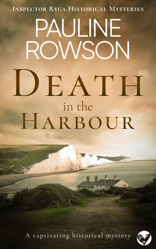
Inspector Ryga is a Scotland Yard detective who is sent out to solve baffling coastal crimes in the 1950s, which means that each Ryga crime novel is set in a different location around the UK. I have fun choosing where I wish to visit (mentally) along our lovely British coastline and then researching it.
To date Ryga has investigated murders on the Royal Island of Portland, Dorset (DEATH IN THE COVE); in Newhaven Harbour, East Sussex (DEATH IN THE HARBOUR); in the small fishing port of Brixham, Devon (DEATH IN THE NETS) and at Hythe, Dungeness, Kent in DEATH IN THE DUNES. I'm currently in Cornwall (metaphorically speaking) writing Inspector Ryga mystery number five.
Location map of where the Inspector Ryga Mysteries are set
Even if I could physically visit all the locations it might not tell me much about what those places looked like in the early 1950s because the landscape has changed so drastically since then with new buildings, town centres, shopping malls, multi-storey car parks, tower blocks, no pedestarian access, one way streets and the decimation of the rail network. There is, therefore, a great advantage to conducting research at a distance, not just for convenience sake but because it would be easy to include something that wasn't actually around at the time, or miss something out if I were to do a modern day walkabout.
To research the locales I browse the wonderful website of the National Library of Scotland Ordnance Survey maps. Often the map I require won't be bang on 1950 or 1951 but most maps were updated in the mid to late 1940s which is near enough, major re-development more generally having taken place in the 1960s onward.
I will pull off copies of the areas chosen and pin then onto a large board which will stay with me as I write the novels while gleaning further location research from historical based websites with wonderful photographs and from personal accounts from those who were raised and lived in the locale. People are extremely helpful when it comes to answering questions about certain aspects of research and I am very grateful to them.
Choosing real places gives me a buzz because I can imagine Ryga and my other characters stalking the streets and coastline. Pouring over old location maps of the era also helps to stimulate imagination and throws up ideas for the story line.
Of course I can't always get everything right, so I use artistic license in the localities, making up fictional streets or house names and numbers, and perhaps renaming the occasional church, or creating a village hall where none might have existed. It is fiction after all. Generally though the places I have chosen reflect what they looked like in the 1950s.
I find all the research aspects on the 1950s intriguing and fascinating whether that be location, policing, transport, social or cultural. It is a world so very differnt to the one we know today but although much has changed, people rarely do.
I hope you enjoy reading them.
Pauline Rowson lives on the South Coast of England and is the best selling author of many crime novels, published by Joffe Books. Her popular crime novels include the DI Andy Horton Solent Murder Mystery series, the Art Marvik mystery thrillers and the 1950s set Inspector Ryga mysteries. Subscribe to her newsletter for all the latest books news.